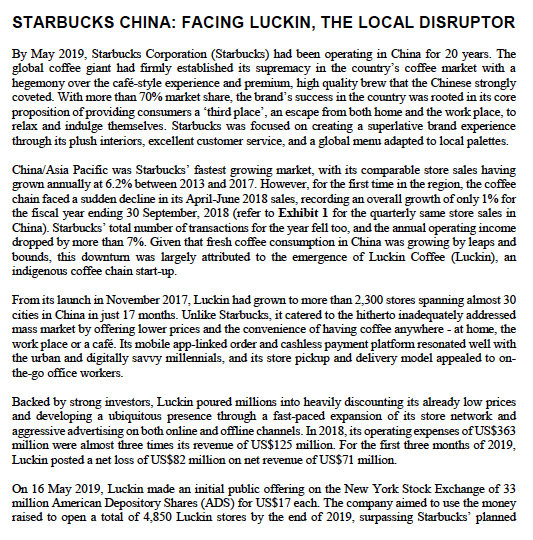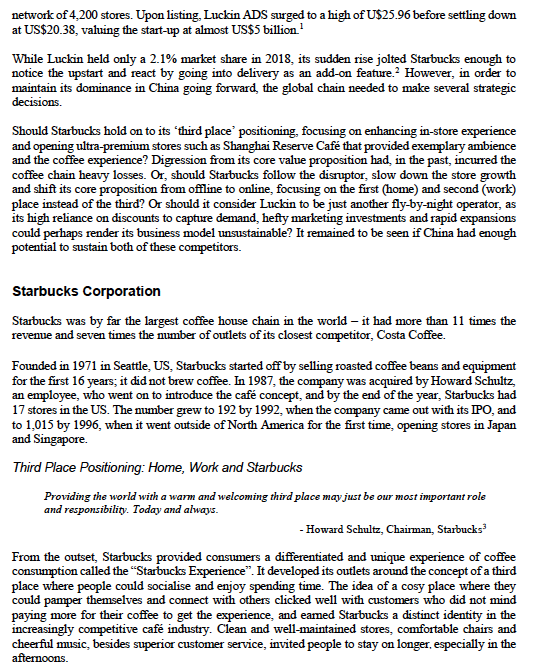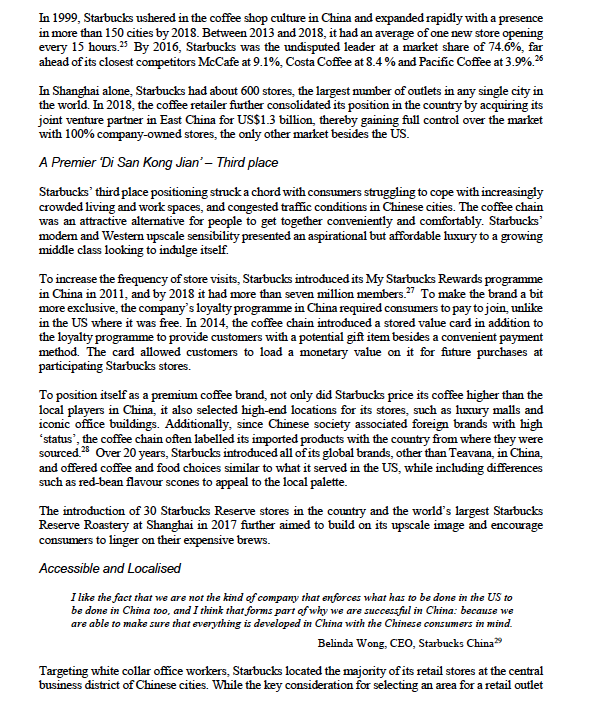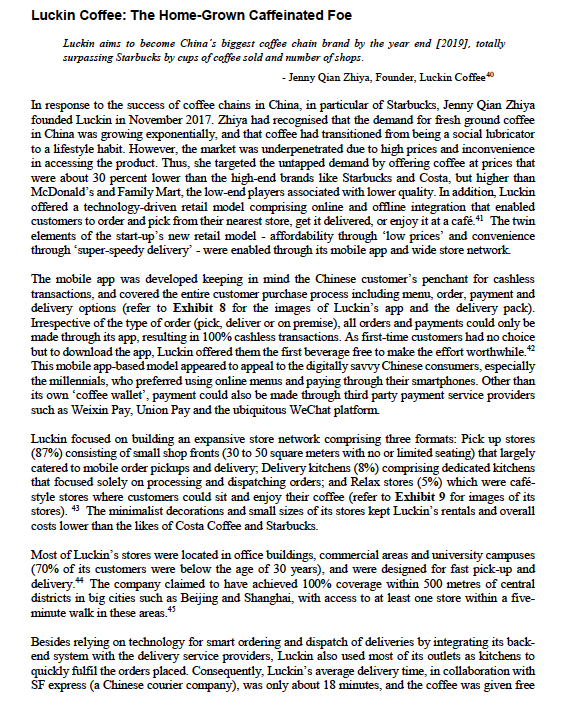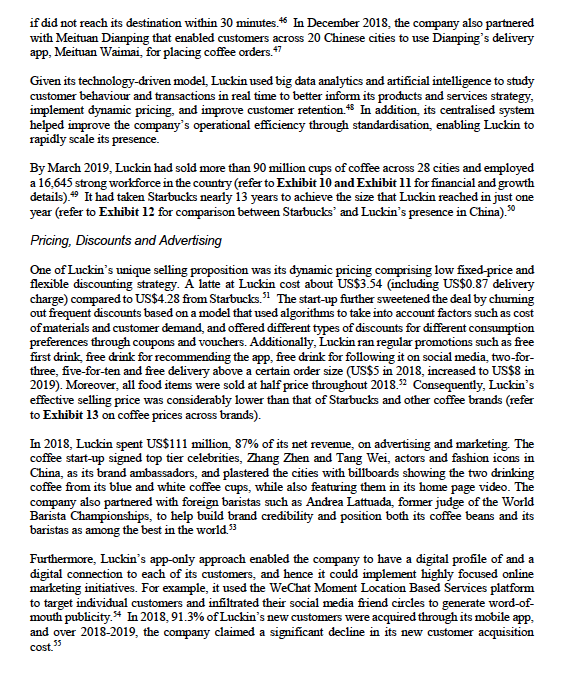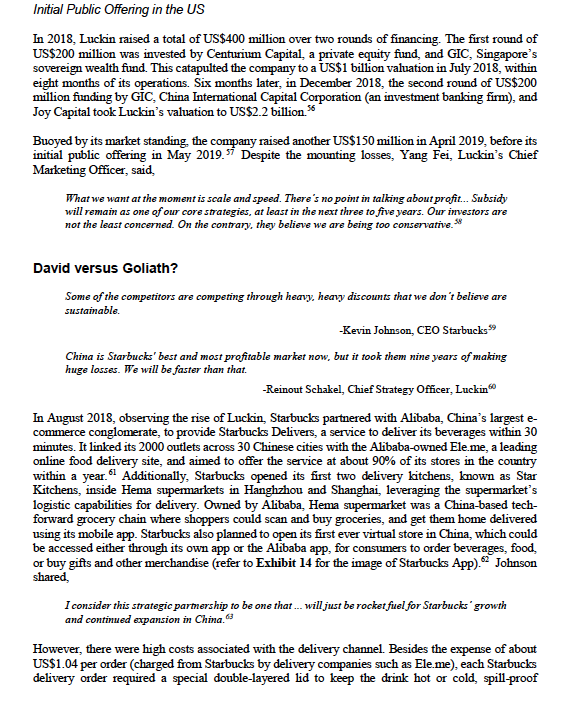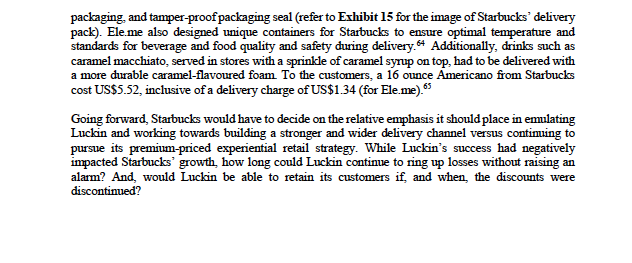what should Starbucks do to more effectively compete against Luckin? Be specific with respect to product, place, price, and promotion
STARBUCKS CHINA: FACING LUCKIN, THE LOCAL DISRUPTOR By May 2019, Starbucks Corporation (Starbucks) had been operating in China for 20 years. The global coffee giant had firmly established its supremacy in the country's coffee market with a hegemony over the cafe-style experience and premium, high quality brew that the Chinese strongly coveted. With more than 70% market share, the brand's success in the country was rooted in its core proposition of providing consumers a 'third place', an escape from both home and the work place, to relax and indulge themselves. Starbucks was focused on creating a superlative brand experience through its plush interiors, excellent customer service, and a global menu adapted to local palettes. China/Asia Pacific was Starbucks' fastest growing market, with its comparable store sales having grown annually at 6.2% between 2013 and 2017. However, for the first time in the region, the coffee chain faced a sudden decline in its April-June 2018 sales, recording an overall growth of only 1% for the fiscal year ending 30 September, 2018 (refer to Exhibit 1 for the quarterly same store sales in China). Starbucks' total number of transactions for the year fell too, and the annual operating income dropped by more than 7%. Given that fresh coffee consumption in China was growing by leaps and bounds, this downturn was largely attributed to the emergence of Luckin Coffee (Luckin), an indigenous coffee chain start-up. From its launch in November 2017, Luckin had grown to more than 2,300 stores spanning almost 30 cities in China in just 17 months. Unlike Starbucks, it catered to the hitherto inadequately addressed mass market by offering lower prices and the convenience of having coffee anywhere - at home, the work place or a cafe. Its mobile app-linked order and cashless payment platform resonated well with the urban and digitally savvy millennials, and its store pickup and delivery model appealed to on- the-go office workers. Backed by strong investors, Luckin poured millions into heavily discounting its already low prices and developing a ubiquitous presence through a fast-paced expansion of its store network and aggressive advertising on both online and offline channels. In 2018, its operating expenses of US$363 million were almost three times its revenue of US$125 million. For the first three months of 2019, Luckin posted a net loss of US$82 million on net revenue of US$71 million. On 16 May 2019, Luckin made an initial public offering on the New York Stock Exchange of 33 million American Depository Shares (ADS) for US$17 each. The company aimed to use the money raised to open a total of 4,850 Luckin stores by the end of 2019, surpassing Starbucks' plannednetwork of 4,200 stores. Upon listing, Luckin ADS surged to a high of U$25.96 before settling down at US$20.38, valuing the start-up at almost US$5 billion While Luckin held only a 2.1% market share in 2018, its sudden rise jolted Starbucks enough to notice the upstart and react by going into delivery as an add-on feature. However, in order to maintain its dominance in China going forward, the global chain needed to make several strategic decisions. Should Starbucks hold on to its 'third place' positioning, focusing on enhancing in-store experience and opening ultra-premium stores such as Shanghai Reserve Cafe that provided exemplary ambience and the coffee experience? Digression from its core value proposition had, in the past, incurred the coffee chain heavy losses. Or, should Starbucks follow the disruptor, slow down the store growth and shift its core proposition from offline to online, focusing on the first (home) and second (work) place instead of the third? Or should it consider Luckin to be just another fly-by-night operator, as its high reliance on discounts to capture demand, hefty marketing investments and rapid expansions could perhaps render its business model unsustainable? It remained to be seen if China had enough potential to sustain both of these competitors. Starbucks Corporation Starbucks was by far the largest coffee house chain in the world - it had more than 11 times the revenue and seven times the number of outlets of its closest competitor, Costa Coffee. Founded in 1971 in Seattle, US, Starbucks started off by selling roasted coffee beans and equipment for the first 16 years; it did not brew coffee. In 1987, the company was acquired by Howard Schultz, an employee, who went on to introduce the cafe concept, and by the end of the year, Starbucks had 17 stores in the US. The number grew to 192 by 1992, when the company came out with its IPO, and to 1,015 by 1996, when it went outside of North America for the first time, opening stores in Japan and Singapore. Third Place Positioning: Home, Work and Starbucks Providing the world with a warm and welcoming third place may just be our most important role and responsibility. Today and always. -Howard Schultz, Chairman, Starbucks From the outset, Starbucks provided consumers a differentiated and unique experience of coffee consumption called the "Starbucks Experience". It developed its outlets around the concept of a third place where people could socialise and enjoy spending time. The idea of a cosy place where they could pamper themselves and connect with others clicked well with customers who did not mind paying more for their coffee to get the experience, and earned Starbucks a distinct identity in the increasingly competitive cafe industry. Clean and well-maintained stores, comfortable chairs and cheerful music, besides superior customer service, invited people to stay on longer, especially in the afternoons.Starbucks' adherence to rigorous standards of quality through controlling the purchasing, roasting packaging and distribution of coffee beans for its global operations, and a suitably adapted food menu catering to local tastes and preferences, helped drive customer loyalty and satisfaction. By 2000, the company had notched up revenues of US$2.2 billion, with double-digit comparable store sales increases. It had more than 3,500 locations across 17 countries, serving more than 12 million customers per week" The coffee chain continued to grow aggressively, adding stores not only in new places but also right next to its existing stores. This strategy, called 'infill', was adopted to reduce the lines and the waiting time for the customers.' Over 2000-2008, Starbucks outlets grew more than threefold, from 5,000 to 16,680. However, in this quest for expansion, the company failed to keep its focus on providing customers a superlative coffee experience. Inadvertently, there was a greater thrust on "take away' than its original value proposition of consumers sitting in the cafe and enjoying their coffee. Consequently, Starbucks' sales growth declined considerably, and there was a drop of 42% in its stock value (refer to Exhibit 2 for the performance details over 2003- 2008). Rebuilding the Starbucks Experience Rebuilding the "third place' equity helped turn Starbucks around. Schultz, having relinquished charge in 2000 and then being reinstated in 2008, immediately set about improving the cafe experience. Besides closing down 600 stores (many of which had been opened in the previous three years), the company worked on training its baristas to improve their art of brewing coffee, bought more advanced coffee equipment and reorganised its supply chain for better inventory management at the cafes. Starbucks also integrated technology to provide consumers a seamless digital experience, improved its social media presence, and introduced customer rewards cards. In order to 'recapture the coffeehouse feel', it redesigned its stores in terms of colours, architecture, lighting, and furniture used In 2014, Starbucks shifted from its no advertising policy and launched its first ever global brand campaign, "Meet me at Starbucks". The campaign, shot in 59 different stores located across 28 different countries, strongly emphasised the relationships customers cultivated when meeting at Starbucks. Over 2016, 2017 and 2018, the coffee chain spent US$248.6 million, US$282.6 million and US$260.3 million respectively, on advertising. Upscaling the Experience: Premium Stores In 2018, Starbucks launched its ultra-premium roastery and reserve project." Reserve Roasteries were essentially coffee emporiums (part cafe and part production facilities), and the Reserve stores were a cafe-only version. While a traditional Starbucks store averaged around 1,800 square feet, the Reserve Roasteries were 10 to 15 times larger and provided an immersive retail experience, including Italian artisan high-end food by Princi bakery, lounge areas with fireplaces and a full liquor bar in addition to a traditional coffee bar showcasing innovative, specialty, small-lot Starbucks Reserve coffee - its premium brand (refer to Exhibit 3 and Exhibit 4 for Starbucks' regular and premium store images). In February 2018, the coffee chain opened its first Reserve store in its Seattle headquarters building that already housed a Roastery (opened in 2014), and by the end of the year opened three more Reserve Roasteries at Milan, Shanghai and New York respectively. " Over the next few years, Starbucks planned to open 30 Reserve Roastery emporiums, 1,000 Reserve stores and install Reservebars at 20 percent of its mainstay stores. According to Kevin Johnson, CEO Starbucks, "The Roasteries are brand amplifiers for us. That is their primary objective."! Liz Muller, Senior VP, creative, global design & innovation, elaborated, While our Roasteries are designed to be bold, educational environments, our Reserve store takes the best of coffee craft as well as artisan baking and layers in a marketplace-style customer experience creating a space that has both energy and moments of intimacy. "? Global and Regional Presence By end-2018, the coffee giant had 29,324 stores across 78 countries, and employed over 291,000 employees worldwide providing the Starbucks Experience more than 85 million times per week. It reported a total revenue of US$24.7 billion, a 10% increase over the previous year. The coffee giant aimed to open 37,000 stores by 2021 (refer to Exhibit 5 and Exhibit 6 for details on financial performance and regional contributions). Coffee Market in China In 2018, the Chinese coffee market was estimated at US$2.4 billion.* The annual average coffee consumption in the country had grown at 15-20% over the last decade compared to the world average of only 2%. Still, China's annual coffee consumption per capita was only 6.2 cups against 209 in Taiwan, 250 in UK and Hong Kong, 279 in Japan, 388 in the US, and 867 in Germany." The coffee consumption trend in the largely tea-drinking nation was predominantly led by urbanisation and a growing middle class."" The discretionary income of the middle class had risen at an annual rate of 8% over the past five years." This increasingly affluent consumer class had greater awareness of Western trends and an aspiration for higher living standards. Global coffee companies capitalised on this need and positioned coffee drinking as a symbol of modern lifestyle and status. 19 Of the three consumer coffee categories: instant coffee (72% market share), ready-to-drink coffee (10%) and fresh ground coffee (18%), the demand for fresh ground coffee, despite being the most expensive, was increasing with the rising trend for "on premise" consumption in the country." In December 2016, there were close to 90,000 coffeehouses in the country, and the market grew at 7.5% over 2017-2018 (refer to Exhibit 7 for the timeline of Chinese coffee drinking culture).21,22 Starbucks: Caffeinateng China If you look at the math, China is over 1.200 times the opportunity size as the U.S. in terms of consumption. We are committed for the long term... We're deploying capital and building 600 new stores per year. -Kevin Johnson, CEO Starbucks 23,24In 1999, Starbucks ushered in the coffee shop culture in China and expanded rapidly with a presence in more than 150 cities by 2018. Between 2013 and 2018, it had an average of one new store opening every 15 hours." By 2016, Starbucks was the undisputed leader at a market share of 74.6%, far ahead of its closest competitors McCafe at 9.1%, Costa Coffee at 8.4 % and Pacific Coffee at 3.9%. In Shanghai alone, Starbucks had about 600 stores, the largest number of outlets in any single city in the world. In 2018, the coffee retailer further consolidated its position in the country by acquiring its joint venture partner in East China for US$1.3 billion, thereby gaining full control over the market with 100% company-owned stores, the only other market besides the US. A Premier "Di San Kong Jian' - Third place Starbucks' third place positioning struck a chord with consumers struggling to cope with increasingly crowded living and work spaces, and congested traffic conditions in Chinese cities. The coffee chain was an attractive alternative for people to get together conveniently and comfortably. Starbucks' modem and Western upscale sensibility presented an aspirational but affordable luxury to a growing middle class looking to indulge itself. To increase the frequency of store visits, Starbucks introduced its My Starbucks Rewards programme in China in 2011, and by 2018 it had more than seven million members."To make the brand a bit more exclusive, the company's loyalty programme in China required consumers to pay to join, unlike in the US where it was free. In 2014, the coffee chain introduced a stored value card in addition to the loyalty programme to provide customers with a potential gift item besides a convenient payment method. The card allowed customers to load a monetary value on it for future purchases at participating Starbucks stores. To position itself as a premium coffee brand, not only did Starbucks price its coffee higher than the local players in China, it also selected high-end locations for its stores, such as luxury malls and iconic office buildings. Additionally, since Chinese society associated foreign brands with high 'status', the coffee chain often labelled its imported products with the country from where they were sourced." Over 20 years, Starbucks introduced all of its global brands, other than Teavana, in China, and offered coffee and food choices similar to what it served in the US, while including differences such as red-bean flavour scomes to appeal to the local palette. The introduction of 30 Starbucks Reserve stores in the country and the world's largest Starbucks Reserve Roastery at Shanghai in 2017 further aimed to build on its upscale image and encourage consumers to linger on their expensive brews. Accessible and Localised I like the fact that we are not the kind of company that enforces what has to be done in the US to be done in China too, and I think that forms part of why we are successful in China: because we are able to make sure that everything is developed in China with the Chinese consumers in mind. Belinda Wong, CEO, Starbucks China Targeting white collar office workers, Starbucks located the majority of its retail stores at the central business district of Chinese cities. While the key consideration for selecting an area for a retail outletwas high traffic, the specific location or building was chosen based on two parameters - its commercial potential, and whether it was a visible and easily accessible location To encourage greater congregation of formal and informal groups of co-workers, friends or family, Starbucks designed its stores in China with an open-style sitting area that had no interior walls and spilled out on walkways and lobbies, and were up to 40% bigger than in the US." Many of its stores were adorned with locally-crafted wine urs and wood carvings to reflect the Chinese heritage. In 2018, the coffee giant established its first Asian R&D centre in China to imbibe from the distinctive Chinese culture and develop a more locally inspired coffee menu." Going Digital To cater to China's highly digitised customers and an increasingly cashless society, Starbucks undertook a number of steps. Through its mobile app, Starbucks enabled the My Starbucks Rewards members to manage their card balance, made it easier to earn and redeem rewards, and find a nearby Starbucks store with the store locator feature. In early 2016, it launched a mobile payment feature enabling its members to e-pay for their purchases at stores nationwide by bundling their pre-loaded Starbucks cards to the Starbucks China Mobile App." Soon after, in December 2016, the coffee chain partnered with WeChat Pay, followed by a tie up with Alipay in 2017 - the two portals that together held 90% of the China's mobile payments market." By 2018, almost 80% of Starbucks transactions in China were cash-free." However, there were no plans to create its own payment system as the company wanted to remain focused on its core business." Given the high penetration level of digital communication in China, Starbucks leveraged local social media platforms for promotions. In 2017, it launched its campaign, "Say it with Starbucks", on the WeChat mobile-messaging app owned by Tencent Holding, the Chinese digital media and telecom conglomerate, that enabled about 826 million users of WeChat to buy a beverage or gift card redeemable at any store in China. 37 While the coffee shop culture in China had come a long way since the entry of Starbucks, it was among the throes of yet another transformation with the emergence of "new retail", a term referring to the seamless integration of offline and online retail. In China's coffee industry, new retail was primarily led by three key factors - a rapidly growing coffee drinking population, a high level of mobile and digital penetration, and most importantly, an increasing demand for delivery by convenience-oriented urban customers living in congested cities. Many offices and apartment buildings had even installed robots to receive orders to avoid overcrowding of the elevators as large number of deliveries were made during meal times. In 2018, revenue in the online food delivery industry in the country amounted to US$34 billion, having grown at 22% over the previous year." With a rise in the number of customers demanding their coffee to be delivered within minutes of ordering (either online or offline), coffee chains, both domestic and international, were scrambling to meet this demand through providing a blend of e- commerce, mobile shopping and brick & mortar storefronts.Luckin Coffee: The Home-Grown Caffeinated Foe Luckin aims to become China's biggest coffee chain brand by the year end [2019]. totally surpassing Starbucks by cups of coffee sold and number of shops. - Jenny Qian Zhiya, Founder, Luckin Coffee In response to the success of coffee chains in China, in particular of Starbucks, Jenny Qian Zhiya founded Luckin in November 2017. Zhiya had recognised that the demand for fresh ground coffee in China was growing exponentially, and that coffee had transitioned from being a social lubricator to a lifestyle habit. However, the market was underpenetrated due to high prices and inconvenience in accessing the product. Thus, she targeted the untapped demand by offering coffee at prices that were about 30 percent lower than the high-end brands like Starbucks and Costa, but higher than McDonald's and Family Mart, the low-end players associated with lower quality. In addition, Luckin offered a technology-driven retail model comprising online and offline integration that enabled customers to order and pick from their nearest store, get it delivered, or enjoy it at a cafe.# The twin elements of the start-up's new retail model - affordability through 'low prices' and convenience through 'super-speedy delivery' - were enabled through its mobile app and wide store network The mobile app was developed keeping in mind the Chinese customer's penchant for cashless transactions, and covered the entire customer purchase process including menu, order, payment and delivery options (refer to Exhibit 8 for the images of Luckin's app and the delivery pack). Irrespective of the type of order (pick, deliver or on premise), all orders and payments could only be made through its app, resulting in 100% cashless transactions. As first-time customers had no choice but to download the app, Luckin offered them the first beverage free to make the effort worthwhile.*- This mobile app-based model appeared to appeal to the digitally savvy Chinese consumers, especially the millennials, who preferred using online menus and paying through their smartphones. Other than its own 'coffee wallet', payment could also be made through third party payment service providers such as Weixin Pay, Union Pay and the ubiquitous WeChat platform. Luckin focused on building an expansive store network comprising three formats: Pick up stores (87%) consisting of small shop fronts (30 to 30 square meters with no or limited seating) that largely catered to mobile order pickups and delivery, Delivery kitchens (8%) comprising dedicated kitchens that focused solely on processing and dispatching orders; and Relax stores (5%) which were cafe- style stores where customers could sit and enjoy their coffee (refer to Exhibit 9 for images of its stores). 4 The minimalist decorations and small sizes of its stores kept Luckin's rentals and overall costs lower than the likes of Costa Coffee and Starbucks. Most of Luckin's stores were located in office buildings, commercial areas and university campuses (70% of its customers were below the age of 30 years), and were designed for fast pick-up and delivery." The company claimed to have achieved 100% coverage within 500 metres of central districts in big cities such as Beijing and Shanghai, with access to at least one store within a five- minute walk in these areas. Besides relying on technology for smart ordering and dispatch of deliveries by integrating its back- end system with the delivery service providers, Luckin also used most of its outlets as kitchens to quickly fulfil the orders placed. Consequently, Luckin's average delivery time, in collaboration with SF express (a Chinese courier company), was only about 18 minutes, and the coffee was given freeif did not reach its destination within 30 minutes.* In December 2018, the company also partnered with Meituan Dianping that enabled customers across 20 Chinese cities to use Dianping's delivery app, Meituan Waimai, for placing coffee orders.* Given its technology-driven model, Luckin used big data analytics and artificial intelligence to study customer behaviour and transactions in real time to better inform its products and services strategy, implement dynamic pricing, and improve customer retention.* In addition, its centralised system helped improve the company's operational efficiency through standardisation, enabling Luckin to rapidly scale its presence. By March 2019, Luckin had sold more than 90 million cups of coffee across 28 cities and employed a 16,645 strong workforce in the country (refer to Exhibit 10 and Exhibit 11 for financial and growth details)." It had taken Starbucks nearly 13 years to achieve the size that Luckin reached in just one year (refer to Exhibit 12 for comparison between Starbucks' and Luckin's presence in China)." Pricing, Discounts and Advertising One of Luckin's unique selling proposition was its dynamic pricing comprising low fixed-price and flexible discounting strategy. A latte at Luckin cost about US$3.54 (including US$0.87 delivery charge) compared to US$4.28 from Starbucks." The start-up further sweetened the deal by churning out frequent discounts based on a model that used algorithms to take into account factors such as cost of materials and customer demand, and offered different types of discounts for different consumption preferences through coupons and vouchers. Additionally, Luckin ran regular promotions such as free first drink, free drink for recommending the app, free drink for following it on social media, two-for- three, five-for-ten and free delivery above a certain order size (US$5 in 2018, increased to US$8 in 2019). Moreover, all food items were sold at half price throughout 2018." Consequently, Luckin's effective selling price was considerably lower than that of Starbucks and other coffee brands (refer to Exhibit 13 on coffee prices across brands). In 2018, Luckin spent US$111 million, 87% of its net revenue, on advertising and marketing. The coffee start-up signed top tier celebrities, Zhang Zhen and Tang Wei, actors and fashion icons in China, as its brand ambassadors, and plastered the cities with billboards showing the two drinking coffee from its blue and white coffee cups, while also featuring them in its home page video. The company also partnered with foreign baristas such as Andrea Lattuada, former judge of the World Barista Championships, to help build brand credibility and position both its coffee beans and its baristas as among the best in the world."3 Furthermore, Luckin's app-only approach enabled the company to have a digital profile of and a digital connection to each of its customers, and hence it could implement highly focused online marketing initiatives. For example, it used the WeChat Moment Location Based Services platform to target individual customers and infiltrated their social media friend circles to generate word-of- mouth publicity." In 2018, 91.3% of Luckin's new customers were acquired through its mobile app. and over 2018-2019, the company claimed a significant decline in its new customer acquisition cost.Initial Public Offering in the US In 2018, Luckin raised a total of US$400 million over two rounds of financing. The first round of US$200 million was invested by Centurium Capital, a private equity fund, and GIC, Singapore's sovereign wealth fund. This catapulted the company to a US$1 billion valuation in July 2018, within eight months of its operations. Six months later, in December 2018, the second round of US$200 million funding by GIC, China International Capital Corporation (an investment banking firm), and Joy Capital took Luckin's valuation to US$2.2 billion." Buoyed by its market standing the company raised another US$150 million in April 2019, before its initial public offering in May 2019." Despite the mounting losses, Yang Fei, Luckin's Chief Marketing Officer, said, What we want at the moment is scale and speed. There's no point in talking about profit... Subsidy will remain as one of our core strategies, at least in the next three to five years. Our investors are not the least concerned. On the contrary, they believe we are being too conservative." David versus Goliath? Some of the competitors are competing through heavy. heavy discounts that we don't believe are sustainable. -Kevin Johnson, CEO Starbucks" China is Starbucks' best and most profitable market now, but it took them nine years of making huge losses. We will be faster than that. -Reinout Schakel, Chief Strategy Officer, Luckin In August 2018, observing the rise of Luckin, Starbucks partnered with Alibaba, China's largest e- commerce conglomerate, to provide Starbucks Delivers, a service to deliver its beverages within 30 minutes. It linked its 2000 outlets across 30 Chinese cities with the Alibaba-owned Ele.me, a leading online food delivery site, and aimed to offer the service at about 90% of its stores in the country within a year." Additionally, Starbucks opened its first two delivery kitchens, known as Star Kitchens, inside Hema supermarkets in Hanghzhou and Shanghai, leveraging the supermarket's logistic capabilities for delivery. Owned by Alibaba, Hema supermarket was a China-based tech- forward grocery chain where shoppers could scan and buy groceries, and get them home delivered using its mobile app. Starbucks also planned to open its first ever virtual store in China, which could be accessed either through its own app or the Alibaba app, for consumers to order beverages, food, shared, or buy gifts and other merchandise (refer to Exhibit 14 for the image of Starbucks App)." Johnson I consider this strategic parmership to be one that ... will just be rocket fuel for Starbucks * growth and continued expansion in China. However, there were high costs associated with the delivery channel. Besides the expense of about US$1.04 per order (charged from Starbucks by delivery companies such as Ele.me), each Starbucks delivery order required a special double-layered lid to keep the drink hot or cold, spill-proofpackaging and tamper-proof packaging seal (refer to Exhibit 15 for the image of Starbucks' delivery pack). Ele.me also designed unique containers for Starbucks to ensure optimal temperature and standards for beverage and food quality and safety during delivery. Additionally, drinks such as caramel macchiato, served in stores with a sprinkle of caramel syrup on top, had to be delivered with a more durable caramel-flavoured foam To the customers, a 16 ounce Americano from Starbucks cost US$5.52, inclusive of a delivery charge of US$1.34 (for Ele.me). Going forward, Starbucks would have to decide on the relative emphasis it should place in emulating Luckin and working towards building a stronger and wider delivery channel versus continuing to pursue its premium-priced experiential retail strategy. While Luckin's success had negatively impacted Starbucks' growth, how long could Luckin continue to ring up losses without raising an alarm? And, would Luckin be able to retain its customers if, and when, the discounts were discontinued
